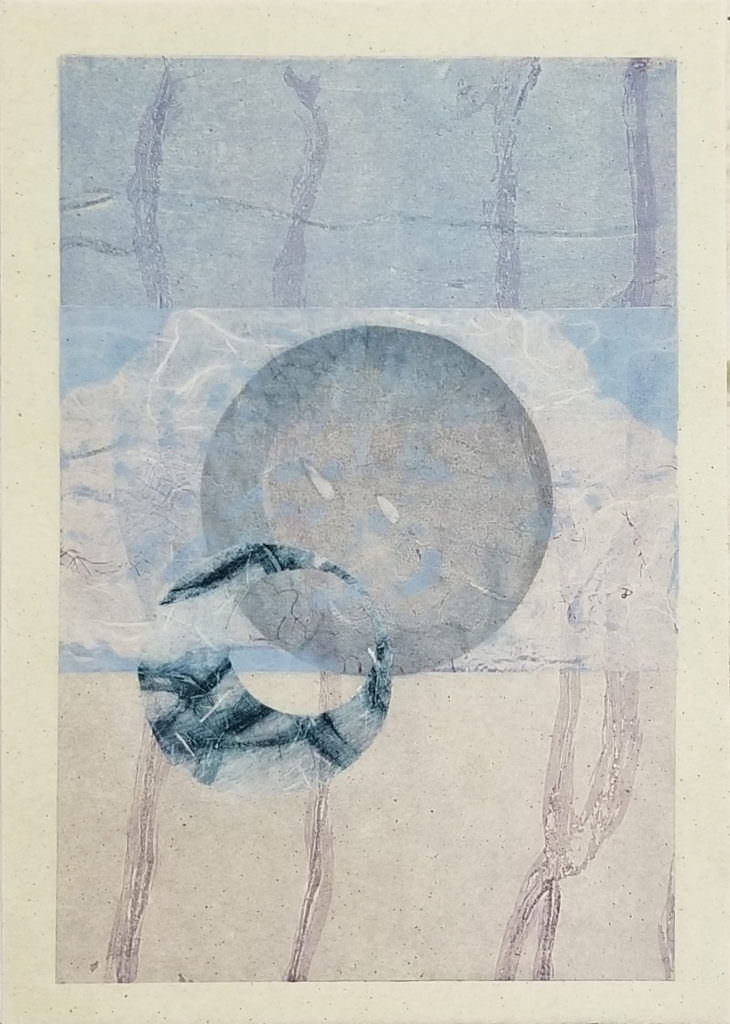Let’s jump in and let Elisa take you on her journey:
How would you define your artwork, technique, and paper application?
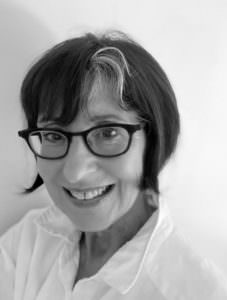
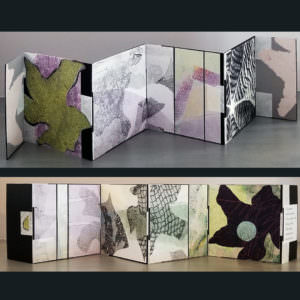
I consider myself a multimedia artist working at the intersection of printmaking, papermaking, and collage. And paper is at the heart of most of my work. My creative process is ongoing – involving eyes, mind, heart, and hands. Color stirs my spirit – – in nature, in art, and in everyday life. I’m always hungry for “fresh” so working across and among different materials and techniques suits me. You will find original hand-pulled prints, collage constructions, handmade paper works, and artist books with my poems. A recent artist book in Leporello style, Now November, is a good example of this convergence. The hinges (using Hemp White washi from Paper Connection) are a meaningful unifying detail in this work. A Leporello is an accordion book that can be unfolded like a panorama.
Share insights into your process and current projects.
This year I was inspired by a song I had heard in a recent workshop on art and racism at Zea Mays Printmaking (Florence, MA), and later, I re-immersed myself in the music of John and Alice Coltrane. I was suddenly struck by John’s simple remedy in times of crisis: “One positive thought produces millions of positive vibrations.” A single vibration provides the spark, vibrations abound, connecting, merging, bridging, and flowering; they ultimately produce the energy needed to build a new and better world. My response was an artist book and box, Positive Vibrations. This work is featured in a current show called “Another World is Possible” in Northampton, MA.
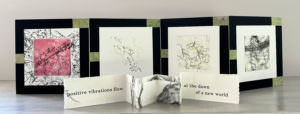
I’m involved in a multitude of processes, many at the same time. Printmaking takes place in my home studio and at Zea Mays Printmaking. Currently, I’m working with a process called Litho Monoprints. Using photographs as a starting point (both mine and my husband’s), I create non-toxic polyester plates that can be inked up for hand-pulled prints. The prints and plate can be modified with different color inks, chine collé, and hand marking. The result is a series of hand-pulled monoprints, each one unique. One of my favorite workspaces for laying out books and collage is the old oak table in my sunny dining room. Then, in the summer I set up some DIY papermaking in my garage in lieu of being in a larger papermaking studio.
I keep notebooks with sketches and writings when I’m working on a project and traveling. I take many photographs of color and light as well as the built world. But, not everything starts as an art project. For example, at one point I became deeply involved in personal family ancestry while I was teaching the history of papermaking. Those two activities inspired me to create art resulting in a solo show called “Silk Roads/Paper Trails.”
I do a lot of envisioning based on something I saw, heard, or read related to a particular subject. I always laugh when I think of Jasper Johns who said, “One night I dreamed that I painted a large American flag, and the next morning I got up and I went out and bought the materials to begin it.” While I don’t paint my dreams per se, I do a lot of dreaming-up artworks at 2 o’clock in the morning.
Why do you create? What is the meaning behind your work? What influences inspire you and why?
Nature, astonishingly simple, yet mysterious is the essence of my art. I work with the phenomena of our physical world tied up with nature as an inherent part of our humanness. Much of my work is about crossings made in transitory times — a shift from season to season, crossing the sea from one shore to another. Chasing the waning light of previous ages or embarking on a new venture, crossings are inevitable.
Given my inclination to wander, I draw inspiration from sojourns to favorite haunts: from Portugal, Venice, and Sicily to the American West and Maine. I am fascinated with seeing how common visual motifs span centuries and geography, emerging in similar and diverse ways in these locales. The sea is a constant – it conveys art, makers, and goods that connect these places. Cultural migrations, conquests, religion, and mythology are woven into the mix.
Lately, I’ve been exploring ways to visually respond to the topsy-turvy 21st-century world we are faced with. What does it even mean to make art today? The resulting works deal with personal and universal reckonings – the havoc wreaked by gun violence, the devastating social and climate effects of fast fashion, geoengineering the climate, and the anguish of refugee journeys to name but a few.
My Shelter in Place series explores the natural human instinct to escape during times of trouble, especially at this pandemic
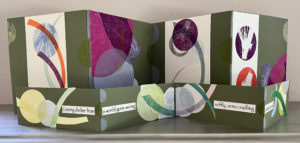
moment. It includes several monotype prints and an artist book called Craving Shelter. A selection of that work is currently on view at The Fountain Street Gallery, Boston.
How did your creative journey bring you to this place?
I grew up in an art household in Rochester, New York. My father was an artist and we kids always had paints, markers, and rolls of paper to play with. At one point I wanted to be a fashion designer and I drew hundreds of shoe advertisements with 60’s era captions like “Spring Fling.” Our family vacations usually involved visiting museums. I remember envying my friends who got to go to the Adirondacks to Santa’s Land while we were stuck at MOMA. Now I treasure that upbringing.
Since then, I’ve created art through study and practice. My college art history and literature studies were accompanied by studio work and later advanced by apprenticeships and workshops. As a 15 + year member of Zea Mays Printmaking Studio, I am skilled in multiple green printmaking practices. Recently I earned the “Certificate in Green Printmaking, Intaglio” from their school. My formative papermaking experience was at Trout Paper, a hand-papermaking atelier in Washington County, New York.
A few years ago, I stepped away from a long career in libraries and museums. While I was making art the whole time, it took a back seat to other pursuits. Now I’ve been recalibrating — moving into life as a full-time artist with all that it entails. I’ve immersed myself in local and regional art communities; Zea Mays Printmaking Studio, The Boston Printmakers, Fountain Street Gallery (Boston), and the Monotype Guild of New England. In addition to making art, I enjoy curating, giving talks, and teaching workshops.
Can you describe the importance of paper (or other mediums) in your work, what type of paper (medium) you use most, and why?
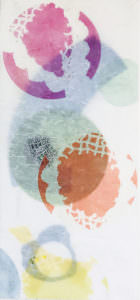
In the early 1980s, I was working at Bennington College as a librarian. There I met one of my art mentors, Sophia Healy, who taught art at the college. She became a seminal influence on both my art and writing. Sophia had worked with Ken Noland when he was experimenting with handmade paper. I joined her papermaking studio called Trout Paper and learned not just about handmade paper but how to approach art as a practice.
I use my own handmade rag paper and all kinds of other paper depending on the work. Like most paper lovers I have a considerable hoard (old, new purchased, traded, found, etc.). For printmaking, I run the gamut, from the substantial Fabriano Pescia to Zerkall Litho to the ethereal Kitakata. Collage affords me the most freedom to explore how papers “react” to each other. For example, a recent work, Soft Landing, comprises two layers of Akua ink monotype prints: a sheet of translucent Unryushi placed over Rives BFK paper.
Why this medium? Can you elaborate/reflect on your work and future forecasting?
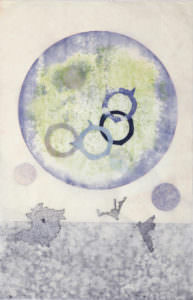 Recto/Verso I, monotype, chine collé, collage, on Hemp Kinwashi paper, printed on both sides, 34 x 22 inches, 2018When I started making artist books, I was looking for ways to move my paper vocabulary into three dimensions by experimenting with text and narrative. It feels natural to express myself in a visual form. I also thrive on solving complex design problems, which is why collage is one of my go-to formats. But the artist’s books are usually smaller scale. A few years ago, I created a large-scale diptych, Recto/Verso I and II, that was suspended from the ceiling and free-floating. Today I’m going back/moving forward with creating larger works that incorporate painting, printmaking, and paper.
Recto/Verso I, monotype, chine collé, collage, on Hemp Kinwashi paper, printed on both sides, 34 x 22 inches, 2018When I started making artist books, I was looking for ways to move my paper vocabulary into three dimensions by experimenting with text and narrative. It feels natural to express myself in a visual form. I also thrive on solving complex design problems, which is why collage is one of my go-to formats. But the artist’s books are usually smaller scale. A few years ago, I created a large-scale diptych, Recto/Verso I and II, that was suspended from the ceiling and free-floating. Today I’m going back/moving forward with creating larger works that incorporate painting, printmaking, and paper.
Are there papers from Paper Connection that you can speak about, provide insights, elaborations, process, and/or integrity of quality?
I discovered Paper Connection International (PCI) many years ago when Lauren did a site visit to Zea Mays Printmaking. My first paper purchase from PCI was a Kozo Honen, which I used to make monotype stencils. Since then, I have always used washi for stencils so that I can reuse them in collage and chine collé.
When I began making hinged accordion books, I needed a strong flexible paper that stood up to frequent opening and closing.
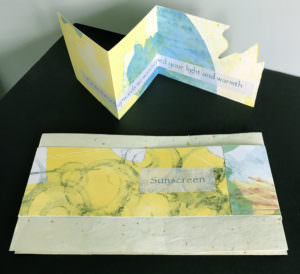
with An-Jing Unryu Heavyweight Mint with Gold Leaf paper cover, 6 x 11 ½ “, 7 pages plus cover and wrapper with stand-up card, 2021
Hanji (Korean mulberry paper) is perfect, especially since there are so many beautiful colors. Sometimes I crave a very special paper to use “as is.” The cover of my artist book Sunscreen is made from the gorgeous An-Jing Unryu Heavyweight Mint, with Gold Leaf. I also love being able to work with PCI papers in my inkjet and laser printers. The Digital and Experimental Photo Paper Sampler provides plenty of options. I now have a paper swatch file to keep myself on track. It’s fun rifling through the papers, feeling the textures, and seeing the array of colors.
I’ve been doing an annual talk called “Rags to Riches: History and Contemporary Perspectives on Papermaking” for the Smith College Book Studies concentration students. For that, I made hinged accordion booklets of curated “Various and Sundry Swatches” for each student. The booklets are unique – the swatches are a mix of my own handmade paper (linen/cotton, plant fibers such as leeks and cornhusks) and Eastern papers (e.g., Echizen from Japan and An-Jing from China) from Paper Connection. These little booklets were born as I was making other artist book projects using upcycled and remixed papers and prints.
Are there questions no one has asked concerning your creative process, philosophy, or recent experience you’d like to share?
People are sometimes shy about asking an artist how they deal with rough patches. I’m an artist, but I also love to cook. Making art is a bit like cooking. Sometimes I don’t know until I “taste” it. I try not to get too caught up in the rightness or wrongness when I’m working. I’ve finally opted out of the “knife of the perfectionist attitude in art” (Louise Bogan, 1934) which is a killer for a creative person (and a cook!).
When I get stuck, it’s usually because I am overthinking or just plain tired. That’s when I let go and allow myself to “rest.” If I’m making paper, I play with forming simple color sample sheets. If I’m printing or doing collage, I stop and photograph the print and flip it upside down. Believe me, right away you can spot the beautiful moments and jarring gaffes in your work!
If you could converse with any artist present/past, who would it be and what would you ask?
Joan Mitchell’s paintings and prints always suck me in with their incredible emotional revelations layered on to nature. I would like to ask her: “How do you deal with overt sentimentality when it enters into your art? How do you draw the line between private emotions that might upset others and the need for our own free expression? Is there a line?”
As you may discern from my art, I am influenced by the late work of Matisse, specifically the cut-outs and stencils. Unfortunately, he had to deal with multiple health problems as he aged; he and I share a particular one. I would ask him: “How did you remain creative while dealing with physical pain? Does aging change your artist’s eye?”
Do you have any upcoming shows or installations in progress? If so, please provide info so we can direct our readers.
Aug. 29 – Sept. 25, 2022 SoWa ArtWalk: Sept. 9th, 5 – 8 pm “Elisa Lanzi, Jim Fenzel, Ellen Foust” Fountain Street Gallery 460C Harrison Ave. #2 Boston MA
Sept. 8 – Oct. 8, 2022 Opening Reception: Friday, Sept. 9th, 5 – 8 pm “Another World is Possible” Zea Mays Printmaking Biennial, Juried by Shichio Minato and Juana Valdes A.P.E. Gallery 126 Main St. Northampton, MA
Do you have an online portfolio or other sites where folks can view more of your work? If so, please provide address.

